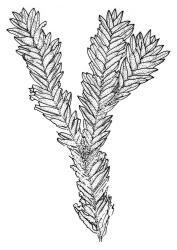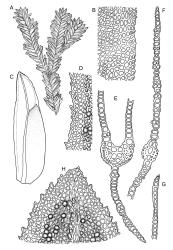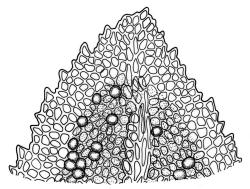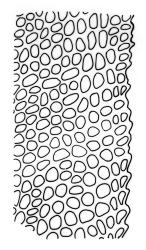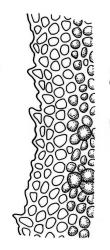- = Fissidens cristatus Mitt., J. Proc. Linn. Soc., Bot. Suppl. 1–2: 137 (1859)
Plants 20–25 mm, yellow-green. Stems occasionally branched, with rhizoids at base only. Leaves in up to 35 pairs, overlapping at mid stem, patent, decurved when moist, little altered when dry, ovate-lanceolate, 3.0–3.2 × 0.8–0.9 mm; apex acute; dorsal and apical laminae with few-celled pluristratose patches; vaginant laminae ⅔ leaf length, almost closed; dorsal lamina extending to leaf insertion, rounded there; margins serrate on dorsal, apical and vaginant laminae, irregularly and coarsely serrate towards the leaf apex; marginal cells of dorsal and apical laminae distinct in several rows, flatter, forming a pale, unistratose band; cells of apical and dorsal laminae quadrate to hexagonal, ± isodiametric, smooth, strongly bulging, with moderately thick walls, (6–)7.5–12.0 × (6–)7.5–12.0 µm, with emergent lamina cells orbicular, to 15 µm diam., in pluristratose clusters. Costa failing 3–4 cells below leaf apex, taxifolius-type in cross-section.
Dioicous? Perichaetia in axils of leaves at mid stem; perichaetial leaves greatly reduced. Perigonia not seen in N.Z. material. Sporophytes not seen in N.Z. material.
Crum & Anderson 1981, fig. 36, F–M (as F. cristatus); Beever et al. 2002, p. 30, figs 1–6; Smith 2004, fig. 77, 11–13.
Fissidens dubius differs from F. adianthoides by having smaller and more bulging laminal cells, which form occasional pluristratose patches in the dorsal and apical laminae. Both species have teeth at the leaf apex large enough to be seen with a ×10 hand-lens, unlike any other Fissidens found in N.Z.
NI: Hawke’s Bay (Maraetōtara Valley, Taradale).
Adventive. Widespread in the northern hemisphere.
The species was recorded new to N.Z. by Bartlett (1984, as F. cristatus Mitt.), based on collections from Maraetōtara Valley, Hawke’s Bay (J.K. Bartlett 23383, WELT M007506) and Tākaka Valley, NW Nelson (J.K. Bartlett 23382, WELT M007510). The Hawke’s Bay material conforms well to type material of F. dubius. The Tākaka Valley record is rejected here; the specimen is referable to F. adianthoides. Additional Hawke’s Bay material has been collected at Taradale in 1973 (B.O. van Zanten, pers. comm., 19 May 2014).
Both confirmed N.Z. specimens are from calcareous rock.
The species is classified as "Introduced and Naturalised" in the N.Z. Threat Classification System (Glenny et al. 2011). The apparent rarity of F. dubius may indicate that it is a recent introduction to this country.



